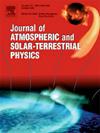1960年以来中国西北干旱半干旱地区降水变异的空间非均质湿润和气候驱动因素
IF 1.9
4区 地球科学
Q3 GEOCHEMISTRY & GEOPHYSICS
Journal of Atmospheric and Solar-Terrestrial Physics
Pub Date : 2025-09-12
DOI:10.1016/j.jastp.2025.106632
引用次数: 0
摘要
本文分析了1960 - 2020年中国西北干旱半干旱区降水的时空演变特征,重点分析了长期趋势、区域差异和气候驱动因素。分段线性回归表明,2000年前后出现了急剧的湿润过渡,降水频率和强度均有所上升。然而,这种趋势在空间上是异质的。模糊聚类揭示了与关键地理分区相对应的四种不同的变化模式。降水变得更加季节性平衡,可能缓解干旱压力。然而,极端降水事件有所加剧,特别是在干旱地区,对脆弱的生态系统构成了越来越大的风险。慢特征分析分离出主要的低变化模式,揭示了NT和NETP主要受El Niño-Southern振荡的影响,NETP滞后2年。低压受东亚夏季风调制。结核主要受欧亚波列型和赤道印度洋海面温度异常的影响。这些结果凸显了中国西北地区水文气候变化的复杂性和区域性差异,迫切需要制定有针对性的适应和水管理策略。本文章由计算机程序翻译,如有差异,请以英文原文为准。
Spatially heterogeneous wetting and climatic drivers of precipitation variability in arid and semi-arid Northwest China since 1960
This study analyzes the spatiotemporal evolution of precipitation across the arid and semi-arid regions of Northwest China from 1960 to 2020, focusing on long-term trends, regional disparities, and climatic drivers. Piecewise linear regression reveals a sharp wetting transition around 2000, characterized by rising precipitation frequency and intensity. However, this trend is spatially heterogeneous. Fuzzy clustering reveals four distinct change patterns that correspond with key geographic subregions. Before 2000, increases were concentrated in the arid Northern Tianshan (NT) and Tarim Basin (TB); after 2000, semi-arid Northeastern Tibetan Plateau (NETP) and Loess Plateau (LP) became dominant contributors. Precipitation become more seasonally balanced, potentially easing drought stress. Yet, extreme precipitation events have intensified, particularly in arid regions, posing escalating risks to the fragile ecosystems. Slow feature analysis isolates dominant low-varying modes, revealing that NT and NETP are primarily influenced by El Niño-Southern Oscillation, with a two-year lag in NETP. LP is modulated by the East Asian summer monsoon. TB is predominantly affected by the Eurasian wave train pattern and equatorial Indian Ocean sea surface temperature anomalies. These results highlight the complex and regionally varied hydroclimatic change across Northwest China, urgently calling for tailored adaptation and water management strategies.
求助全文
通过发布文献求助,成功后即可免费获取论文全文。
去求助
来源期刊

Journal of Atmospheric and Solar-Terrestrial Physics
地学-地球化学与地球物理
CiteScore
4.10
自引率
5.30%
发文量
95
审稿时长
6 months
期刊介绍:
The Journal of Atmospheric and Solar-Terrestrial Physics (JASTP) is an international journal concerned with the inter-disciplinary science of the Earth''s atmospheric and space environment, especially the highly varied and highly variable physical phenomena that occur in this natural laboratory and the processes that couple them.
The journal covers the physical processes operating in the troposphere, stratosphere, mesosphere, thermosphere, ionosphere, magnetosphere, the Sun, interplanetary medium, and heliosphere. Phenomena occurring in other "spheres", solar influences on climate, and supporting laboratory measurements are also considered. The journal deals especially with the coupling between the different regions.
Solar flares, coronal mass ejections, and other energetic events on the Sun create interesting and important perturbations in the near-Earth space environment. The physics of such "space weather" is central to the Journal of Atmospheric and Solar-Terrestrial Physics and the journal welcomes papers that lead in the direction of a predictive understanding of the coupled system. Regarding the upper atmosphere, the subjects of aeronomy, geomagnetism and geoelectricity, auroral phenomena, radio wave propagation, and plasma instabilities, are examples within the broad field of solar-terrestrial physics which emphasise the energy exchange between the solar wind, the magnetospheric and ionospheric plasmas, and the neutral gas. In the lower atmosphere, topics covered range from mesoscale to global scale dynamics, to atmospheric electricity, lightning and its effects, and to anthropogenic changes.
 求助内容:
求助内容: 应助结果提醒方式:
应助结果提醒方式:


